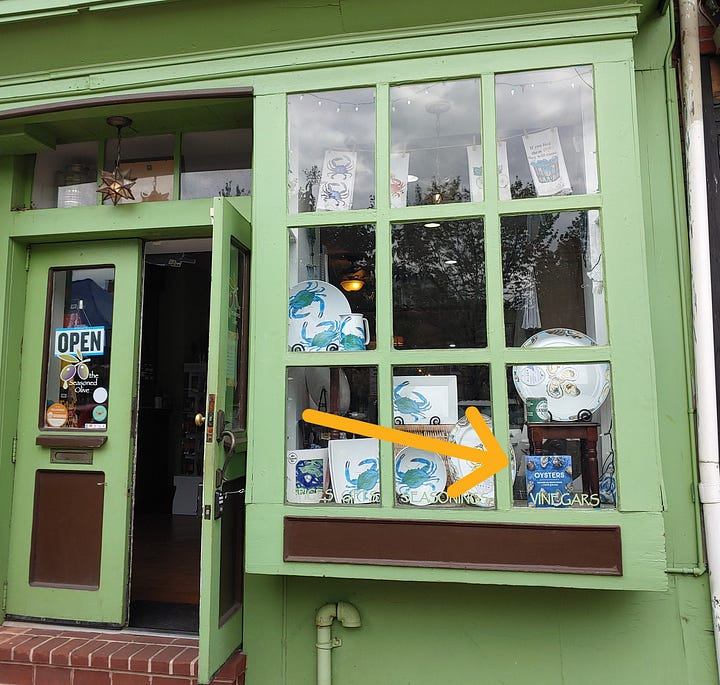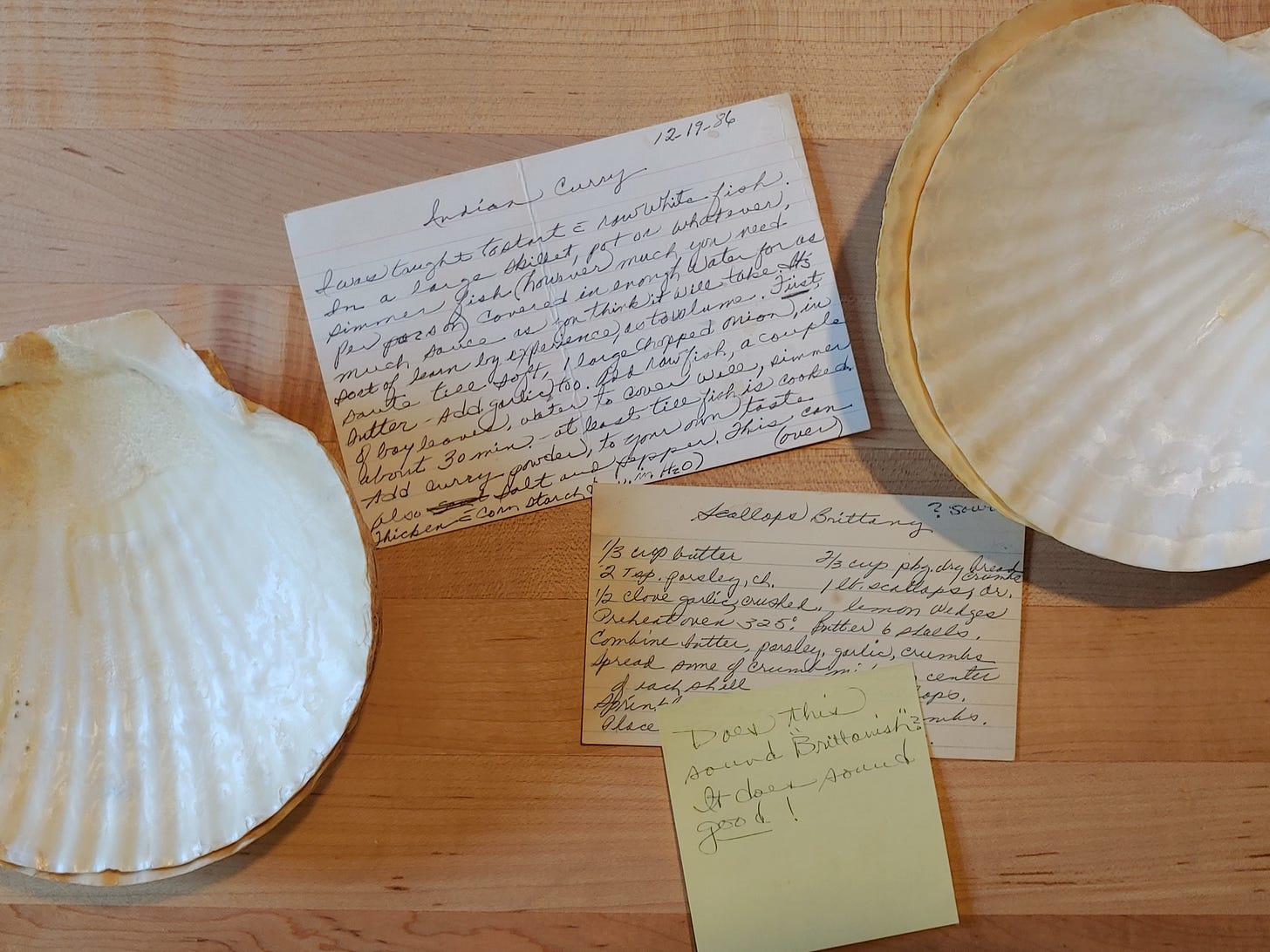A Preservation Mindset, Part One
A bit of Oysters news, keeping family food traditions alive and rosemary-roasted crab
I had what was becoming a very long newsletter in the works, trying to cover two different interpretations of the term “preservation.” In the interest of getting at least part of that out sooner (it has a slight holiday-season connection), it will come to you in two parts instead.
Today I’ve got the preservation of family food traditions on my mind, more on which is below. And I’ll be getting into the preservation of seafood populations and the environments in which they thrive—dipping into seafood sustainability as the theme of Part Two. Both have links to the past—traditions, enterprises, culture, sustenance—and ties to our future. (There are certainly other versions of preservation, such as smoking and pickling seafoods, that I’ll get into as well down the line.)
By now the holiday season is well under way. I hope celebrations thus far have been fabulous and those still to come will be merry and bright. Here’s to a New Year abundant with joy, adventure, love, comfort, and delicious moments shared with family and friends. Plus seafood. Lots and lots of outstanding seafood!
First Up: a Bit of Oysters News
My book Oysters: Recipes that Bring Home a Taste of the Sea came out in paperback earlier this month! I’m thrilled the book, originally released in 2016, is still being published and due to be around at least a few more years. This was a particularly fun book to write, I learned a great deal along the way and valued the excuse to play around with oysters so much in recipe-development—which makes it extra gratifying that folks remain interested in the content. Some original hardcover versions will be in circulation for a bit, I imagine, the new paperbacks more broadly available.


It’s been a joy to happen upon Oysters while traveling, fun to see where the book ends up. Wandering around Baltimore in October, it was a delightful surprise to see Oysters in the window of The Seasoned Olive while strolling around the Fell’s Point neighborhood. And I’ll never forget the wild experience of exploring the waterfront area in Auckland, New Zealand, the morning we landed in 2018, glancing into The Shucker Brothers and seeing my book on display on their oyster bar. I definitely thought I was jet-lag hallucinating. Went back, after a bit of rest, and had a great meal—it’s a spot to put on your list for any future Auckland visits. While there, we slurped some Te Kouma oysters from Coromandel Oyster Company where we stopped for lunch later in the trip, thanks to the recommendation. Another example of how traveling with seafood in mind can take you some wonderful places!
Preserving Family Food Traditions
While seafood has been getting by far the bulk of my attention in the past few years, I do get equally enthusiastic about another passion of mine: encouraging people to preserve family recipes and food traditions. I’ve been collecting lots of notes on the subject, when I come across examples of “lost” family recipes that someone’s lamenting and/or working to track down (which inspired this blog post I wrote a couple of years ago) or hear a story about different ways people are gathering and recording those traditions. I’ve gone so far as to develop a writing workshop I call “Preserving Family Recipes”, which I’ve led once so far—it was super fun, such an engaging group, lots of great discussion. I’ll be working to schedule more of those, for sure.

I can’t get enough of hearing stories people have to share about their family’s food traditions, the recipes served at every birthday/picnic/holiday meal/etc. Whether it’s a conversation with family, friends, or strangers, posing a simple question about foods they grew up with or favorite family recipes—it’s sure to elicit some interesting discussions. And I get double-bonus enthusiastic when a family story happens to include seafood.
One favorite example was a conversation I had at a culinary conference, with an attendee I sat next to at a lunch who was from a farming family in Iowa. He told me about the oyster soup that was served exactly twice each year when he was growing up: once on the last day of corn harvest as a celebration and once on Christmas Eve. He recalled the soup being very simply, just oysters, milk and butter. I *live* for stories like these.
Another example came to mind a couple weeks ago while thinking about recipes and family, this post written by Ted Kennedy Watson who owns a couple fabulous gift stores in downtown Seattle. It’s a touching story about his mom’s shrimp dip that she served at every family gathering. I love his comment about fresh shrimp being an option, but that he usually uses a couple small cans of tiny shrimp to most closely replicate his mom’s version. And his reflection that “This really just takes me back to my youth and Midwest roots. It is amazing how food and tastes and flavors can do just that.” That’s what it is ALL about!
I could go on and on, obviously. My key message for today is this: with holiday gatherings on tap, think about those beloved, traditional dishes that are part of your family’s story and shared experience. If you don’t have the recipe(s) yet for these treasures, ask for them. And most importantly: don’t let the opportunity slip by to talk with the person who makes it, learn what you can about the recipe’s story and how it came to be a family favorite. You’ll be all the more thankful in years to come to have both the recipe, and the story, to share with others.
Below are a few seafood-focused highlights from the photo above, which includes the scallop shell dishes my mom used for so many years. It makes me very happy to feel the connection with her when I use them for my own dinner parties; I haven’t yet cooked the Scallops Brittany but plan to soon, I’ll fill you in on that later. The way she wrote that curry recipe warms my heart, as if speaking to me. It’s pretty hilarious how non-specific the recipe is, but it does the job of at least capturing the steps for how she made the dish. The me of 1987 might have had a hard time recreating it successfully without her by my side. The me of today values so very much being able to prepare this fish curry with a strong sense that she is by my side.
Rosemary Roasted Crab
In honor of the opening for commercial Dungeness crab harvest in the Northwest a week or so ago, I’m sharing this recipe from Crab. It’s one of my all-time favorite recipes from among the very many—seafood or not—that I’ve come up with over the years. Quick, delicious, and easy-but-celebration-worthy, with an extra bonus of being exquisitely aromatic. I’ll be serving this for a dinner with friends from out of town who are visiting next week, perhaps with a little crab cocktail to start too.
Cooked, cleaned, portioned Dungeness crab are gently tossed with fresh sprigs of rosemary, sliced lemon, chopped garlic and a sprinkle or two of chile flakes. The roasting doesn’t take long, just enough time for the crab to be heated through and the aromatic character to infuse the meat a bit. Lightly cracking the shells before cooking helps the meat take on those flavors, while prepping for easier eating later. The light toasting of the shells while roasting adds its own bit of flavor as well. You won’t need to call anyone to the table, the aroma alone will do that for you.
2 Dungeness crab (about 2 pounds each), cooked, cleaned and portioned, shells lightly cracked
6 to 8 long sprigs fresh rosemary
1 large lemon, thinly sliced
1/4 cup olive oil
4 cloves garlic, chopped
1/4 teaspoon dried red pepper flakes
Kosher salt and freshly ground black pepper
Preheat the oven to 450°F.
Lay the crab portions in a 9- by 13-inch (or similar) baking dish and top with the rosemary sprigs and lemon slices. Add the olive oil, garlic, and pepper flakes, and season generously with salt and pepper. Toss with your hands to coat the crab pieces evenly with the seasonings, arranging them finally in an even layer with most of the rosemary and lemon underneath. Roast until the crab is heated through, 7 to 10 minutes.
Transfer the crab pieces to a serving platter, surround them with the rosemary sprigs and lemon slices, and serve. Have a discard bowl available for shells, and provide plenty of napkins.
Makes 2 to 4 servings






